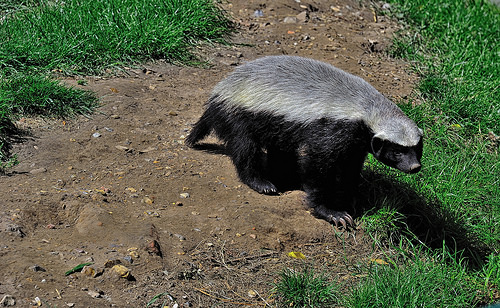Are you as crazy for honey as a honey badger?
- Honey badgers are mammals that are native to parts of Asia and Africa, and they do not have the appearance of a typical badger.
- ‘Honey badgers’ are also known as ‘ratels’, and they have the scientific name Mellivora capensis, and are from the family Mustelidae, the family of weasels and other mammals.
- Most honey badgers have fur typically coloured black with an upper white stripe, and they have baggy skin that allows freedom of movement, that is particularly advantageous when being attacked.
- Honey badgers range from 55 to 77 centimetres (22 to 30 inches) in length, excluding the tail, and weigh 5 to 16 kilograms (11 to 35 pounds).
- A honey badger typically lives by itself, however, others may be found nearby when looking for food, especially in breeding periods.
A Honey Badger
Image courtesy of Steve Slater/Flickr
- Honey badgers live in 1 to 3 metres (3.3 to 9.8 feet) long burrows underground, that can be dug in as little as ten minutes, and they can also climb and swim.
- Honey badgers have robust skin that can deflect bites, stings and punctures, making it a hard animal to kill, and they will also attack aggressively and release a smelly odour, and are therefore unpopular prey.
- The diet of honey badgers includes honey, bee larvae, insects, eggs, rodents, birds, amphibious animals, vegetation, and reptiles, including venomous snakes and turtles, and they consume all components of their prey including shell, bones, fur, and feathers.
- Honey badgers that live near livestock owned by humans can be a significant nuisance, as it is difficult to kill the badger and prevent it from capturing and eating the animals.
- Female honey badgers typically give birth to one or two cubs at a time, and can live up to 24 to 26 years in captivity.
Bibliography:
Honey Badger, 2014, Wikipedia, http://en.wikipedia.org/wiki/Honey_badger
Honey Badger (Ratel), 2014, San Diego Zoo, http://animals.sandiegozoo.org/animals/honey-badger-ratel







